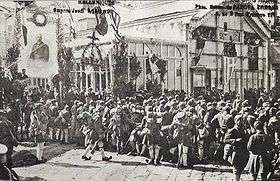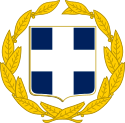Evzones
The Evzones or Evzonoi (Greek: Εύζωνες, Εύζωνοι, pronounced [ˈevzones, ˈevzoni]), is the name of several historical elite light infantry and mountain units of the Greek Army. Today, it refers to the members of the Presidential Guard (Greek: Προεδρική Φρουρά, translit. Proedrikí Frourá), a ceremonial unit that guards the Greek Tomb of the Unknown Soldier (Greek: Μνημείο του Άγνωστου Στρατιώτη, translit. Mnimeío tou Άgnostou Stratiόti) and the Presidential Mansion in Athens. An Evzone (Greek: Εύζωνας) is also known, colloquially, as a Tsoliás (Greek: Τσολιάς; pl. , Τσολιάδες, Tsoliádes). Evzones are known for their distinctive uniform, which evolved from the clothes worn by the klephts[1] who fought the Ottoman occupation of Greece. The most visible item of this uniform is the fustanella, a kilt-like garment. Their distinctive dress turned them into a popular image for the Greek soldier, especially among foreigners.
Etymology
The word evzōnos (Greek: εὔζωνος[2]) is first attested in Homer's Iliad and derives from εὖ and ζώνη, meaning "well-girt". The word was used by ancient writers for centuries to describe a type of light infantry of unidentified equipment, probably used as a generic term to denote light infantry.
History
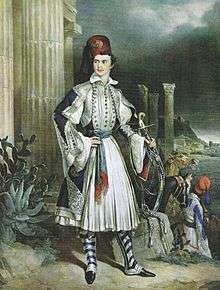
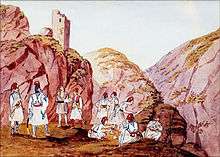


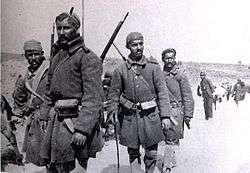
In 1833, after the arrival of King Otto, the Greek Army was organized along new lines. The Bavarian soldiers that had come with Otto formed the majority of the "European" Line Infantry battalions (Greek: Τάγματα Γραμμής; Tágmata Grammís). Each of these units included one rifle company, designated as "Skirmishers" (Greek: Λόχος Ακροβολιστών; Lókhos Akrovolistón) or "Evzone" (Greek: Λόχος Ευζώνων; Lókhos Evzónon). In addition, ten light "Skirmisher" battalions (Greek: Τάγματα Ακροβολιστών; Tágmata Akrovolistón) were formed from Greeks, dressed in a uniform based on the garb of the klephts of the War of Independence (1821–1829). In 1836 these battalions were reduced to four, and eight "Mountain Guard" battalions (Greek: Τάγματα Οροφυλακής; Tágmata Orofylakís) were formed in their stead; they were grouped into four regiments in 1843. These units were primarily engaged in patrolling the frontier, combating insurgents and hunting down the many brigands that infested the countryside. The Mountain Guard was incorporated in the strengthened "Skirmisher" battalions in 1854.
On 12 December 1868, King George I signed a Royal Decree authorized the creation of four independent (αὐθύπαρκτα) Evzone Battalions (Τάγματα Εὐζώνων), "forming part of the Army's regular strength and intended especially for service on the frontier, and in providing assistance to the Gendarmerie.[3] Each battalion was to be commanded by a lieutenant colonel or a major, with a staff of 4 officers and 6 NCOs, and comprising four companies of 122 officers and men each. Their personnel were to be exclusively career and volunteer soldiers, rather than draftees. Prospective recruits had to be of good health and character, over 17 and under 40 years of age, and preferably unmarried.[3] On the same day, due to the precarious security situation, the King also provisionally authorized the creation of eight further Evzone Battalions, numbered 5–12, as well as the increase of each Evzone company's strength to 170.[4] In addition, on the same day a special detachment, initially named Agema (Άγημα), the precursor of the modern Presidential Guard, composed of two Evzone infantry companies and a cavalry company, was formed.[5] In 1880-1881, the Evzone units were expanded to nine battalions. They participated in the disastrous 1897 war with Turkey as elements of the regular infantry divisions. In the aftermath of the war, through various reorganizations, the number of Evzone battalions varied from eight to six, operating either independently or divided between the infantry divisions, and were among the first units to be equipped with machine guns.
At the time of the Balkan Wars, eight Evzone battalions were in existence. They operated independently on the vanguard or the flanks of the army. They distinguished themselves for their fighting spirit suffering high casualties, especially among officers. Subsequently the Evzone units were increased to five regiments, which fought with distinction as elite shock troops in the First World War, the Asia Minor Campaign and the Greco-Italian War.
During the German invasion in 1941, a memorable event is said to have occurred: on April 27, as the German Army was entering Athens, the Germans ascended to the Acropolis of Athens and ordered the young Evzone who was guarding the flag post, Konstantinos Koukidis (q.v.), to haul the Greek flag down and replace it with the swastika flag. The young soldier did so, but refused to hand over the Greek flag to the Germans, and instead wrapped himself in it and fell off the Acropolis to his death.
After the occupation of the country, in 1943, the collaborationist government raised a number of "Security Battalions" (Τάγματα Ασφαλείας), which were dressed in the Evzone uniform and participated in operations against the EAM-ELAS partisans.[6] They were derisively known as Germanotsoliades ("German Evzones") or Tagmatasfalites ("Security Battalionists"), and were disbanded after liberation in 1944.
After the war, the reconstituted Hellenic Army did not re-establish the Evzone regiments, their elite status and role being assumed by the newly established Mountain Raiding Companies. The traditions and distinctions of the Evzones are, however, maintained by a special ceremonial unit, which has served under several names: Palace Guard (Greek: Ανακτορική Φρουρά), Flag Guard (Greek: Φρουρά Σημαίας), Tomb of the Unknown Soldier Guard (Greek: Φρουρά Μνημείου Αγνώστου Στρατιώτη), Royal Guard (Greek: Βασιλική Φρουρά) and after 1974, with the abolition of the monarchy, the Presidential Guard (Greek: Προεδρική Φρουρά). Several regular Army Infantry units have been given the numbers and names of the post-1913 Evzone Regiments, however, these names are only honorific.
Former units
The historical units were numbered and known as Τάγμα Ευζώνων ("Evzone Battalion") or Σύνταγμα Ευζώνων ("Evzone Regiment"). The first Evzone Regiment was formed in 1912, shortly before the outbreak of the Balkan Wars. The "traditional" and well-known Evzone regiments, which fought in World War I, the Asia Minor Campaign, and World War II, were formed after the Balkan Wars by the Royal Decree of 23 December 1913. Since the regiments were distinctive, elite units, they had dual numbers—the first, numbering them in the Evzones order of seniority, the second, in the overall infantry hierarchy. Thus the 5/42 Evzone Regiment was the 5th Evzone regiment, but also the 42nd infantry regiment.
- 1/38 Evzone Regiment, the former 1st Evzone Regiment, based in Karditsa and recruited in Thessaly
- 2/39 Evzone Regiment, based in Missolonghi and recruited in Aetolia-Acarnania
- 3/40 Evzone Regiment, based in Arta and recruited in Epirus
- 4/41 Evzone Regiment, based in Veroia and recruited in western Macedonia
- 5/42 Evzone Regiment, based in Lamia and recruited in Central Greece
Uniform
In 1833, the uniform of the Evzones (as in all infantry companies of the line battalions) was in the unpopular Bavarian style of blue trousers, tailcoats and shako. As light infantry the Evzones were distinguished only by green braid and plumes. In 1837, a new uniform was created based on the traditional fustanella style worn by the klephts, armatoli, and many of the famous fighters of the Greek War of Independence. At first, it was only issued to the native light infantry battalions, but its popularity led to its adoption as the official uniform of the Evzones in 1868.
In the 1868 regulations, officers and warrant officers continued wearing the regular Army uniform, but the men of the Evzone battalions were issued a special uniform of a white wool jacket (φέρμελη) with dark blue cord embroidery (γαϊτάνια), with the battalion number embroidered in crimson at the end of each sleeve. The jacket was also decorated with two rows of twelve yellow metal buttons in the chest, and eight on the sleeves. A fez (φέσιον) with a silk tassel, bearing the national cockade and the crown was worn on the head, and a knee-length fustanella of white cloth below, closed by a belt of cotton in blue and white stripes. On the feet were worn tsarouchia, and white wool leggings and garters, the former decorated like the west in dark blue embroidery. For poor weather, an "iron-coloured" knee-length cap was issued.[3]
During the remainder of the 19th century, the dress of the separate line battalions of Evzones appears to have differed slightly in detail between units.[7] After a few minor changes over the years, it became the familiar uniform seen worn today by the Presidential Guard. In 1910 a new field service uniform was adopted, substituting a khaki farion cap and khaki doulama jacket for the respectively red and dark blue garments previously worn.[8] The long white woolen hose and turned-up tsarouchia shoes were still retained, although sometimes replaced on campaign by the standard khaki trousers and leather boots of the line infantry.[9] The khaki and off-white field uniform of 1910 was still being worn during the Greek-Italian War of 1940-41, although without the red collar piping and shoulder straps of the earlier uniform. The traditional black fez tassel and large shoe pompoms were usually removed before battle.[10]
Notable Evzones
References
- ↑
- ↑ εὔζωνος, Georg Autenrieth, A Homeric Dictionary, on Perseus
- 1 2 3 Royal Decree of 12 December 1868, published in ΦΕΚ 63/1868, pp. 440–442
- ↑ Royal Decree of 12 December 1868, published in ΦΕΚ 62/1868, p. 430
- ↑ Royal Decree of 12 December 1868, published in ΦΕΚ 63/1868, pp. 438–440
- ↑ Thomas, Nigel. Partisan Warfare 1941-45. p. 38. ISBN 0-85045-513-8.
- ↑ Rene North, page 123 "Military Uniforms 1686-1918", SBN 600 00118 0
- ↑ Jowett, Philip S. Armies of the Balkan Wars 1912-13. p. 43. ISBN 978-1-84908-418-5.
- ↑ Thomas, Nigel. Armies in the Balkans 1914-18. pp. 45–46. ISBN 1-84176-194-X.
- ↑ Athanassiou, Phoebus. Armies of the Greek-Italian War 1940-41. p. 43. ISBN 978-1-4728-1917-8.
Sources
- Mylonas, Yiannis (1998). Οι Εύζωνοι (in Greek). Athens: Ioannis Floros. ISBN 960-7178-39-4.
- Κολόμβας, Νικόλαος (2009). 2/39 Σύνταγμα Ευζώνων. Σελίδες από την πολεμική ιστορία του [2/39 Evzone Regiment. Pages from its war history.] (2nd ed.). Αιτωλική Πολιτιστική Εταιρεία (ΑΙ.ΠΟ.Ε).
- Αλεξόπουλος, Σωτήρης (2012). Το Ημερολόγιο του Εύζωνα Χρήστου Δ. Αλεξόπουλου [The Diary of the Evzone Christos D. Alexopoulos]. Kavala: Ξυράφι. p. 267. ISBN 978-960-89430-6-3.
External links
| Wikimedia Commons has media related to Evzones. |
- Greek Presidency
- Historical Photographs at Βικιπαίδεια
- Athens Info Guide
- Athens In Pictures
- BootsnAll
- great travel pictures
- Article of newspaper Ethnos about the Evzones uniform (in Greek)
- Article of newspaper Ethnos about the Evzones (in Greek)
- "Meet the 'unflinching' Greek Presidential Guard"- BBC News feature
